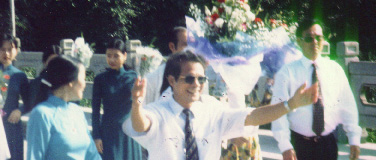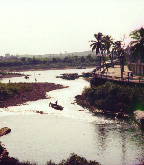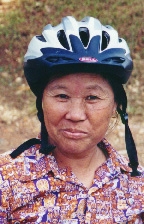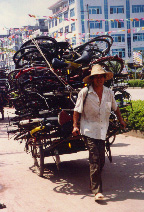

|
 A riverside village in the coastal plain. |
We started from the hotel on bicycle, proceeding to the outskirts of Feng Chang. There was a fragrance to the air from the lumber that was being sawed in front of the workshops. We turned right and headed south, and soon were waved through a toll booth that marked the beginning of a two-lane highway to the coast. (The tolls were for motorized traffic&emdash;because of the great distances involved, the road was used primarily by cars and trucks.) This was pleasant work, again mostly downhill with gentle valley scenery tucked between ridges and hillocks until we began to catch glimpses of the river delta broadening out into the South China Sea. The road now turned south westerly, and we began tracing the coastline, sometimes swerving inland but usually within sight of the sea.
|
|

|
I stopped for a breather at a small bridge and took a look down at a little stream. A woman was washing clothes just a dozen feet below me. Sensing my shadow, she looked up and gave a startled cry. I tried to wave reassuringly, but she seemed a little upset. Dong and some other riders came up, and she came around and up the bank to where we were, now curious. Dong must have explained things satisfactorily, because she showed no hesitancy in examining our strange bicycles and equipment. At one point we managed to convince her to try on a bicycle helmet.
|
|
 Canal culture is still very much extant in the south.
|
Back on the road we passed aqueducts, canals, irrigation works, and even an old furnace, all familiar signs of water-driven industry still in operation. It was very much like stepping back in time to the Potomac River in the early 1900s. After another 15 or so miles, we began to see signs of a modern city. This was the Chinese side of the border, divided from Vietnam by a small river. When I came to a bridge I looked around cautiously. There was a welcoming arch on the other side. I didn't see any signs of guards or customs. It was 1 o'clock -- perhaps we had arrived in the middle of the traditional 2-hour siesta, and would be able to traipse into N. Vietnam without inspection or ceremony. (This was, of course, purely fantasy.)
|
|
 Glaring sunlight, new buildings -- the future's so bright you have to wear shades in the town of Dongxing. We saw innumerable carts along the way bearing old bicycles, (presumably for recycling?). (photo by stephanie lin)
|
Another couple of riders showed up, and we determined to press on. The road now turned into a stunning boulevard that might well have heralded the city of Oz. The concrete pavement reflected brightly in the mid day sun, creating a shining path towards the new high-rises that had suddenly sprung from the broad plains ahead. This was the Chinese border town of Dong Xing, a brand spanking new testament to the normalization of trade relations between the People's Republic of China and the Socialist Republic of Vietnam. For, in fact, Vietnam's most recent conflict was a 1979 renewal of the centuries-old tradition of border wars with their northern neighbors. Judging from this modern metropolis, China was enjoying the fruits of the relaxed trade restrictions. In point of fact, the balance of trade is tilted in China's favor at present. While the Vietnamese are making up for years of lost consumption by buying Chinese goods, they have not yet succeeded in building up their manufacturing capacity to compete domestically and abroad. Here guides were waiting to flag us over to a sidewalk for cold drinks. When the group had rallied, we rode on another half-mile to a hotel for lunch. We created a bit of a stir among the well-heeled clientele, but were quickly whisked away to a quiet back room, either for our own privacy, or to protect the restaurant clientele from "moral corruption." (That's the English phrase the authorities use to warn visitors against importing or exporting forbidden texts or pictures.) Once again, I was faced with a procession of strangled goose, immolated pork, and gaping carp. I resigned myself to a bowl of rice and steamed vegetables, augmented by chunks of fish. It actually was a fine diet, it just seemed awkward to be refusing most of the food brought to the table by our elegantly-attired attendants. Soon, however, fatted like calves, we had to move on, out into the model city, now turned into a glaring blast furnace by the noontime sun. It was less then a mile to the border, the last bit of it over a chewed-up dirt track through a back alley that was in the process either of construction or major repair.
|
|
 The Friendship Bridge leads us to the stone portal into Vietnam.
(photo by mike high)
(photo by beckmann/levy) |
And now began the process of "passport formalities," in the official parlance. We had to transfer all of our gear across the "Friendship Bridge" because, despite the warm relations between these socialist neighbors, the bureaucratic difficulties in getting our Chinese truck and van across the river were insurmountable. (In my experience, the ceremonial use of the word "friendship," as in Friendship Bridge, usually connotes the recent or imminent danger of unfriendliness, at least in the communist lexicon.) Once processed through the Chinese border post, we went back out to say goodbye to Daisy and Mr. Muoi, and get our bicycles. About two-thirds of the way across the bridge, we were met by a reception committee of elegantly dressed women bearing flowers and provincial officials, welcoming us to Vietnam. State television was there to film the event, which turned into a modest opportunity for speech-making (with the Mississippians taking center stage) and endless photo opportunities. When all was said and done, we were asked to return to the middle of the bridge, where our baggage had been piled, and opened some pieces for inspection. If recollection serves, that's when we loaded up the little Daewoo truck that was to accompany us to Hanoi. Then we finished our walk across the bridge to begin the immigration customs "formalities." Unfortunately, some of the visas listed ports of entry other then Mong Cai. (In several cases, members of our group had copies of their applications showing "Mong Cai," but it evidently had not been correctly transcribed by the Vietnamese embassy.)
|
|
|
More than 100 areas along the 800-mile border between Vietnam and China have been under dispute since the border war of 1979. Since the normalisation of relations, the two countries have engaged in eight years of negotiations on border issues which culminated in an agreement signed two months after our visit. "In 30 hours, mankind will usher in a new millenium. At this moment we cherish all the more dearly the hard-won peaceful environment and the traditional friendship." (Chinese Foreign Minister Tang Jiaxuan, speaking at the signing ceremony) While the land border
has been defined, Vietnam and China have not settled their
competing claims in the Tonkin Gulf and the South China Sea
(or "East Sea," to the Vietnamese).
|
|
|
Then, at last, we were urged to mount our equipment and were set loose on the road south. This began as a promising wide boulevard to match the one on the Chinese side, except there were nothing but the shanties nearby, with water buffalo and other livestock gratuitously wandering over the median strips. The boulevard had little traffic and appeared to go nowhere; we were pointed off to the right into the busy, older, and decidedly less prosperous town of Mong Cai. The first thing I checked at the modest little hotel was the bathroom, which had the most important commodity, a Western-style toilet. However, it had no tub or shower stall. I assumed we'd have to shower somewhere down the hall, until Greg pointed out the shower head and the drain in one corner of the tile floor &endash; the whole bathroom was the shower stall.
|
|
Typical exports (approx. $9 billion) from Vietnam to other countries: crude oil, marine products, rice, coffee, rubber, tea, garments, shoes. Imports (approx. $11 billion): machinery and equipment, petroleum products, fertilizer, steel products, raw cotton, grain, cement, motorcycles.
|
Vietnam time was an hour earlier than in China (which maintains one time zone for its vast territory), so sunset was marked at 5:30PM. We walked a half-block and across the traffic circle to get to the night's restaurant. This was a good opportunity to learn about the intricacies of navigating the streets on foot (if you're thinking about crosswalks and traffic lights, think again). When crossing streets radiating from a traffic circle, one must be alert to traffic approaching from the right, traffic spinning out of the circle to your left, and traffic approaching from the street behind you making sharp 90º turns up your back side. For residents, crossing is largely a matter of faith-stepping out into the whirling traffic with the certain knowledge that if you maintain a steady, predictable pace, the bicycles and motorbikes will adjust their speed and angle to avoid you. I prefer the method of "ferrying" that I learned from kayakers. That means waiting until you see a seam forming in the traffic, and then starting out slowly, keeping an eye upstream, and letting the traffic adjust to you where possible. But be careful, if the seam is formed between bicycles in from and a bunch of motorcycles behind, it will close quickly on you. The restaurant was not as elegant as the ones we'd seen in China, but that actually came as a bit of a relief to me. We were ushered through the crowded foyer to a glassed-in side room. Here we had a chance to get to know our chief Vietnamese guide, Dong, a little better. He was a thin man who spoke rough English and seemed a little nervous about leading this inaugural ride. Admittedly, it was going to be quite a challenge. Over the next week he would have to try to satisfy the peculiar requests and irrepressible curiosity of his Western guests, while at the same time presenting a positive and non-controversial image of the country. We had a rather large entourage on this side of the border, including a doctor, so it was clear that they didn't want accidents of any kind to spoil our favorable impression of the country. Conversely, both Zhi Wei and Dong seemed to relax a bit now that we had technically left their sphere of responsibility. Zhi Wei livened things up a bit when he said that Dong didn't look Chinese, and that his father had been a Russian. To this, Dong chuckled and said confidently, "That's bullshit." His family had come from the north, and he was part Manchurian. I can't recollect what I ate that night, but on most of the rest of the trip Dong (from Vietnam) would specifically request a vegetarian dish for me. As a consequence, I dined very well below the border, though I was still a picky enough eater to flatter myself that I was trimming down a bit.
|